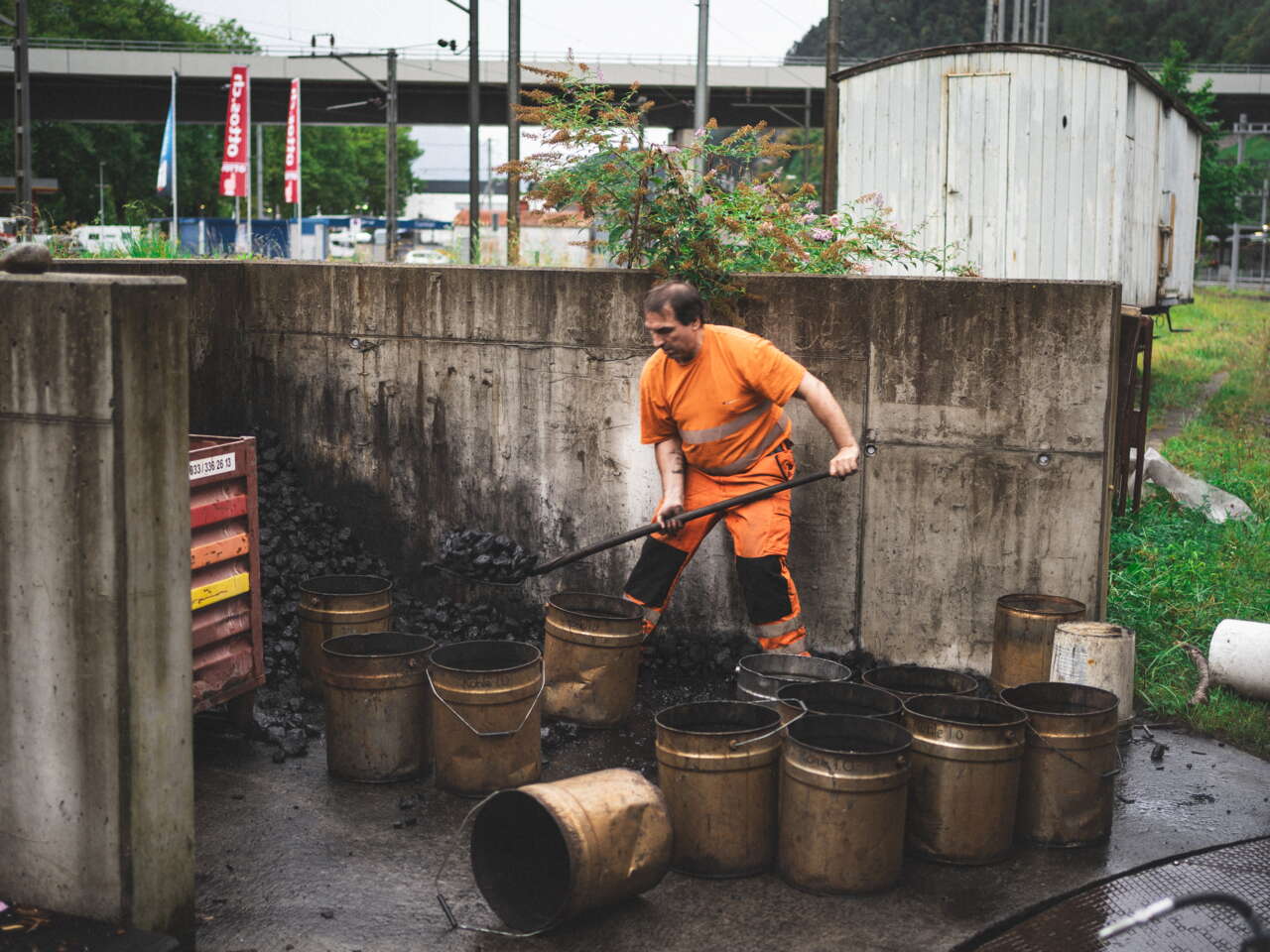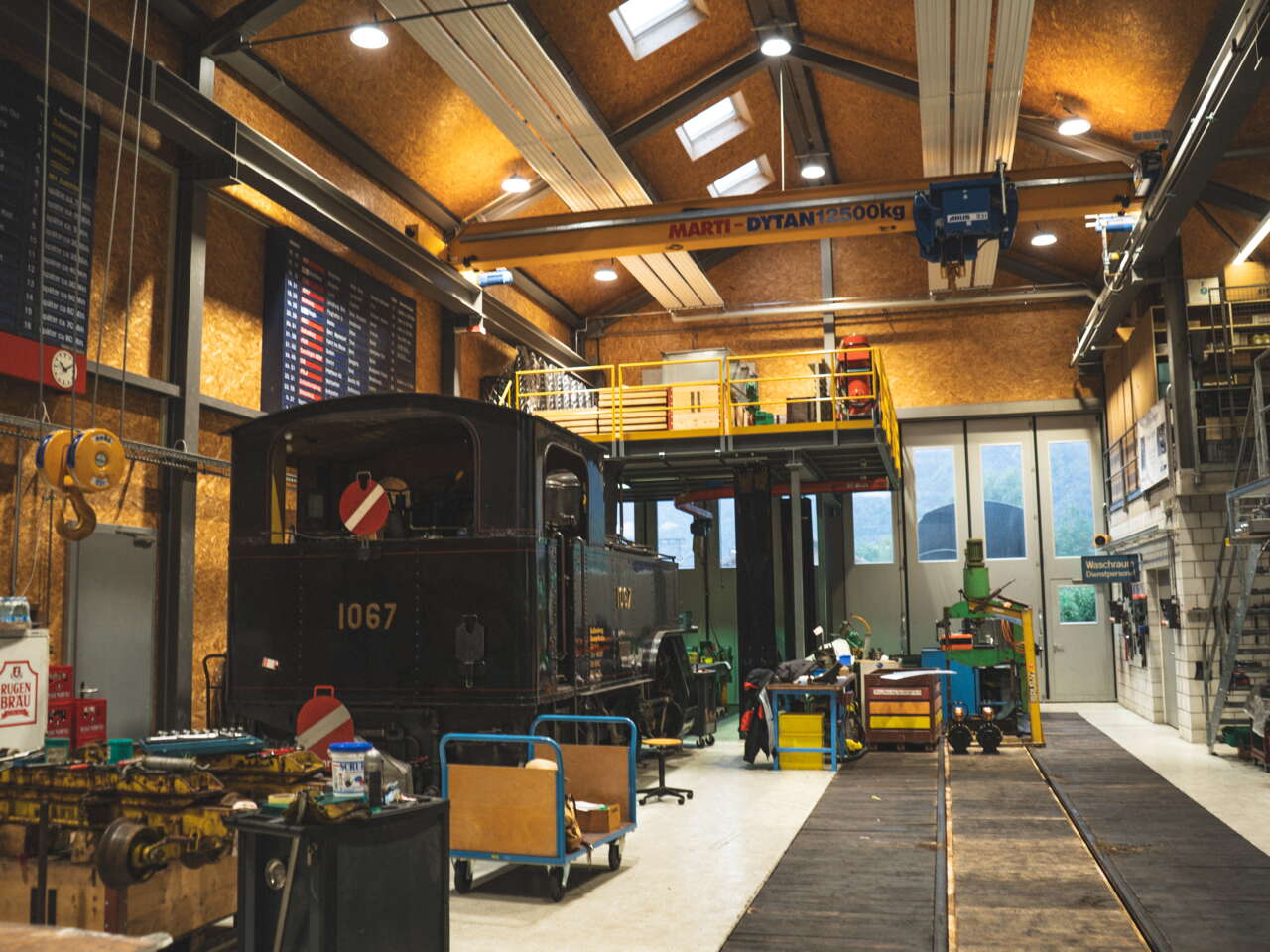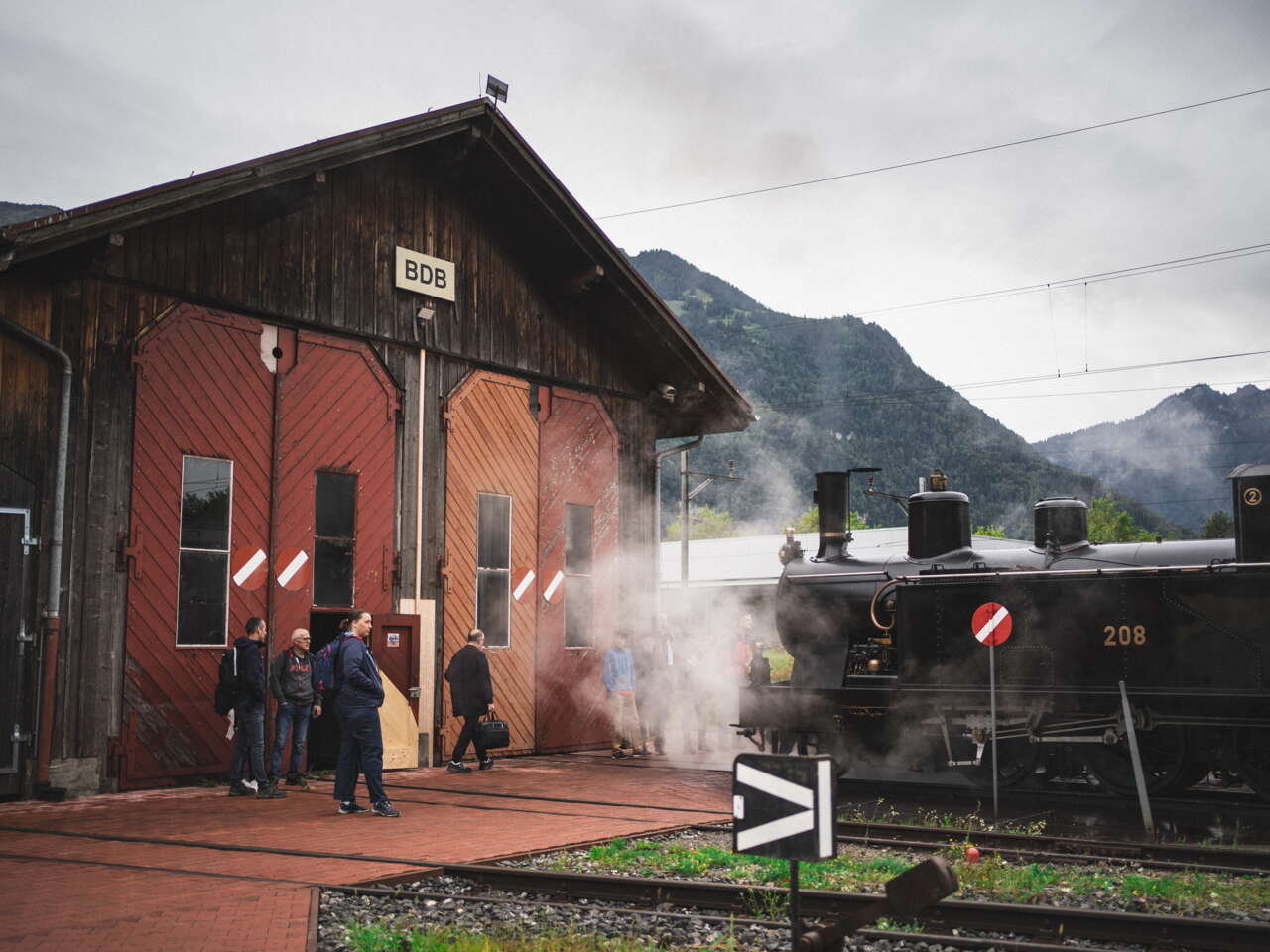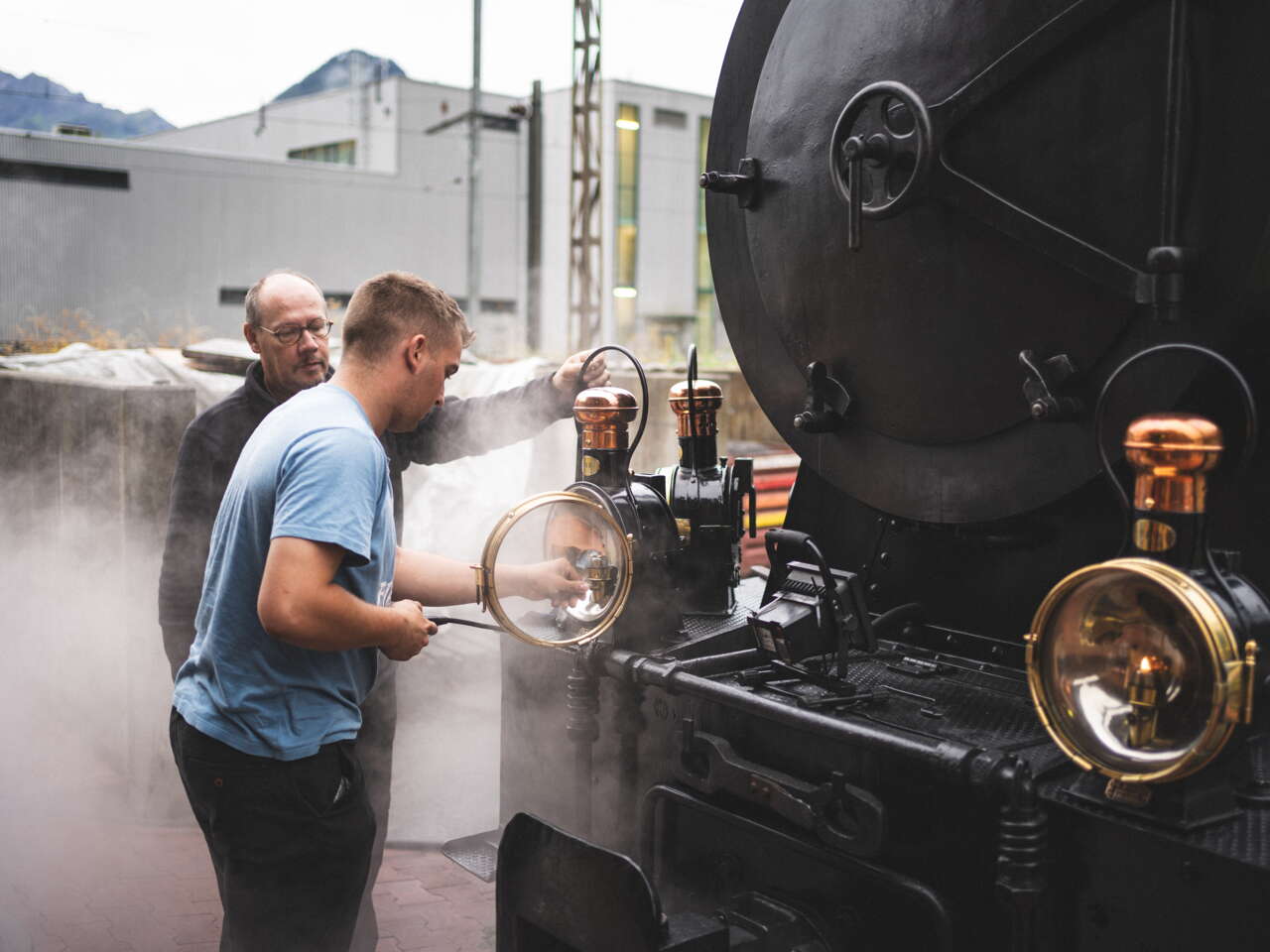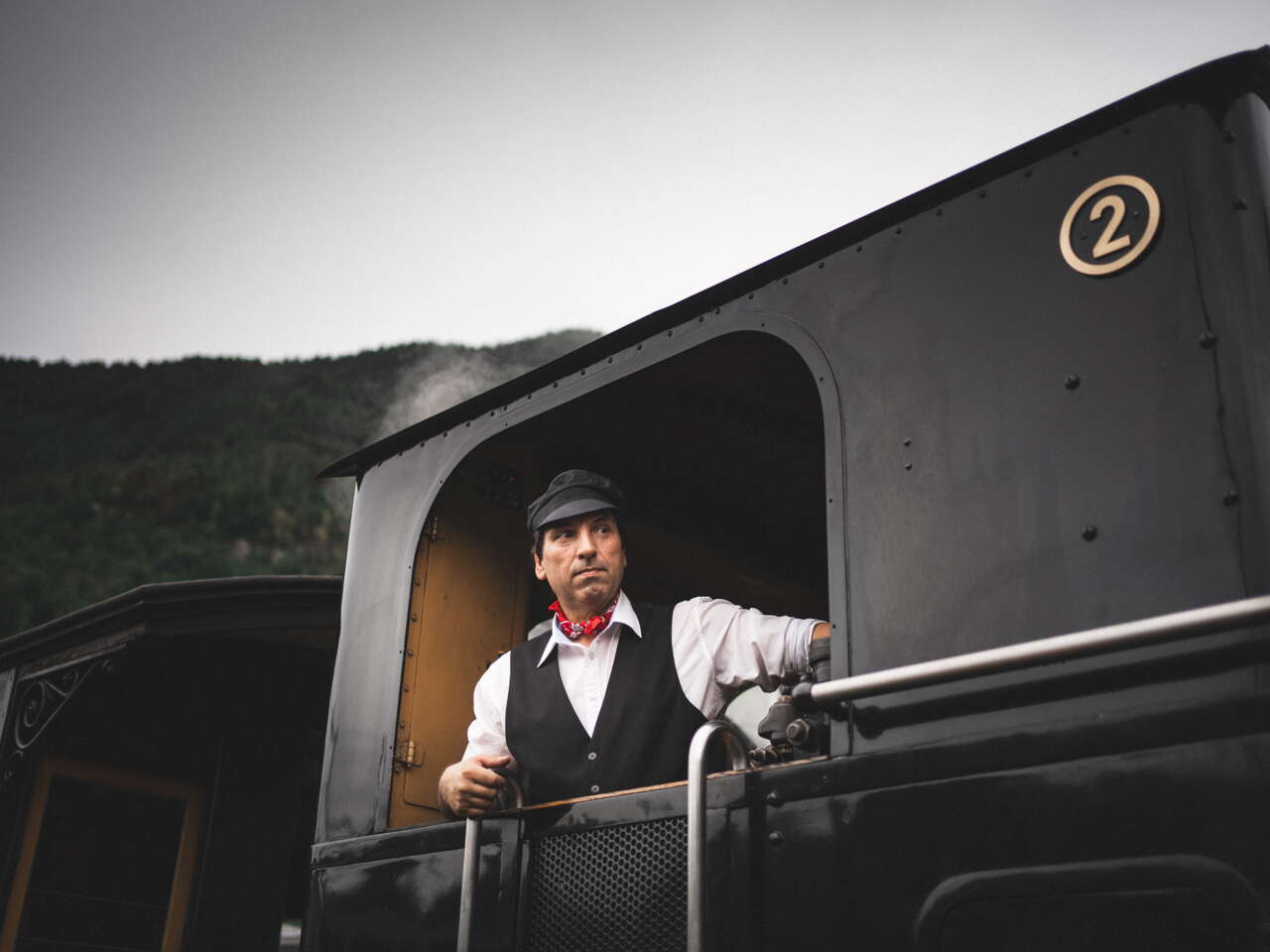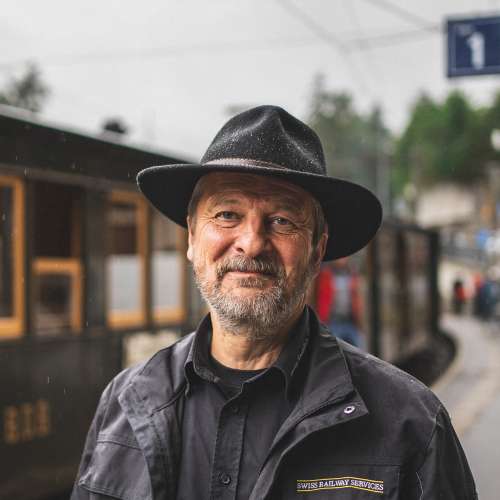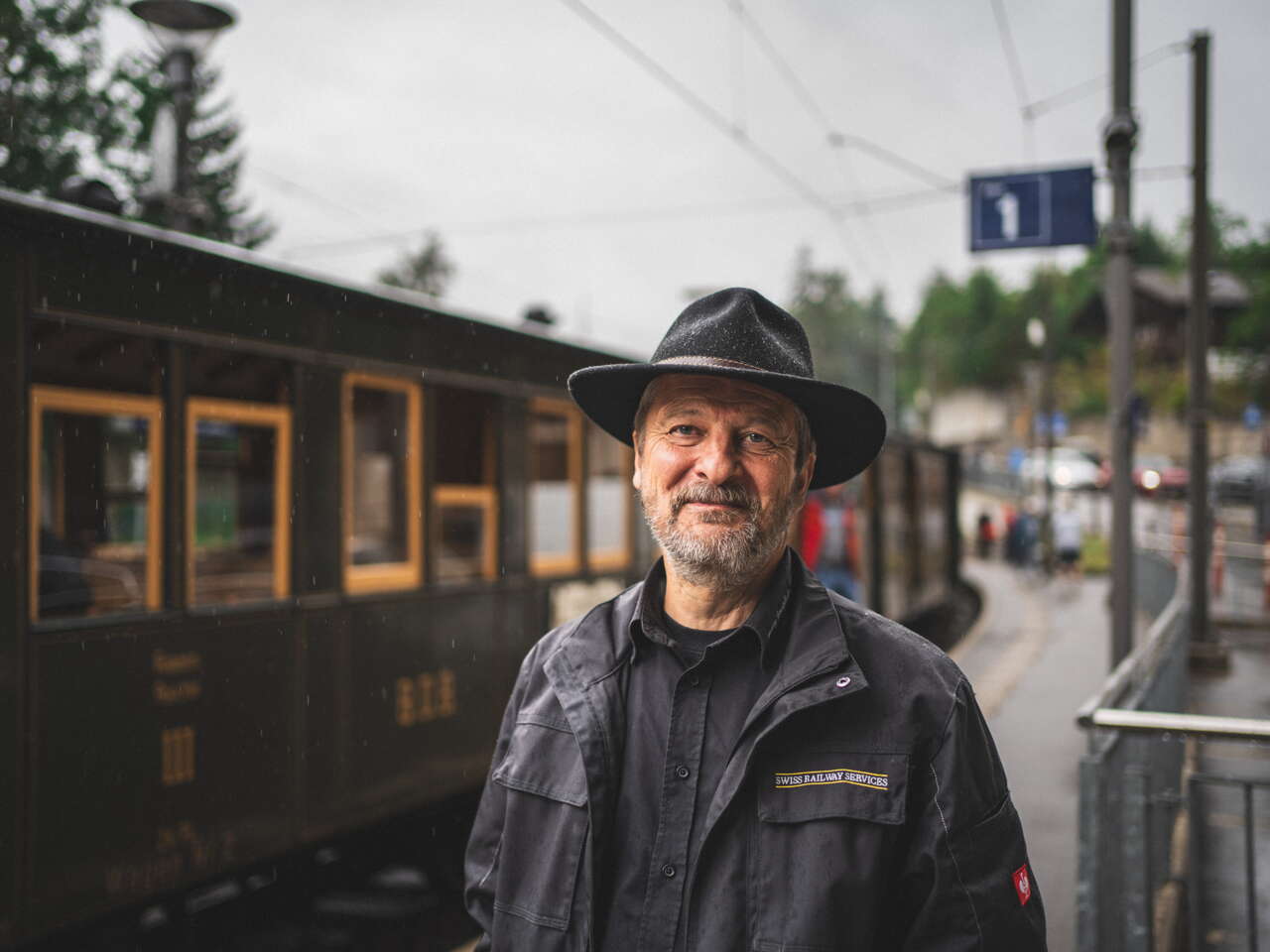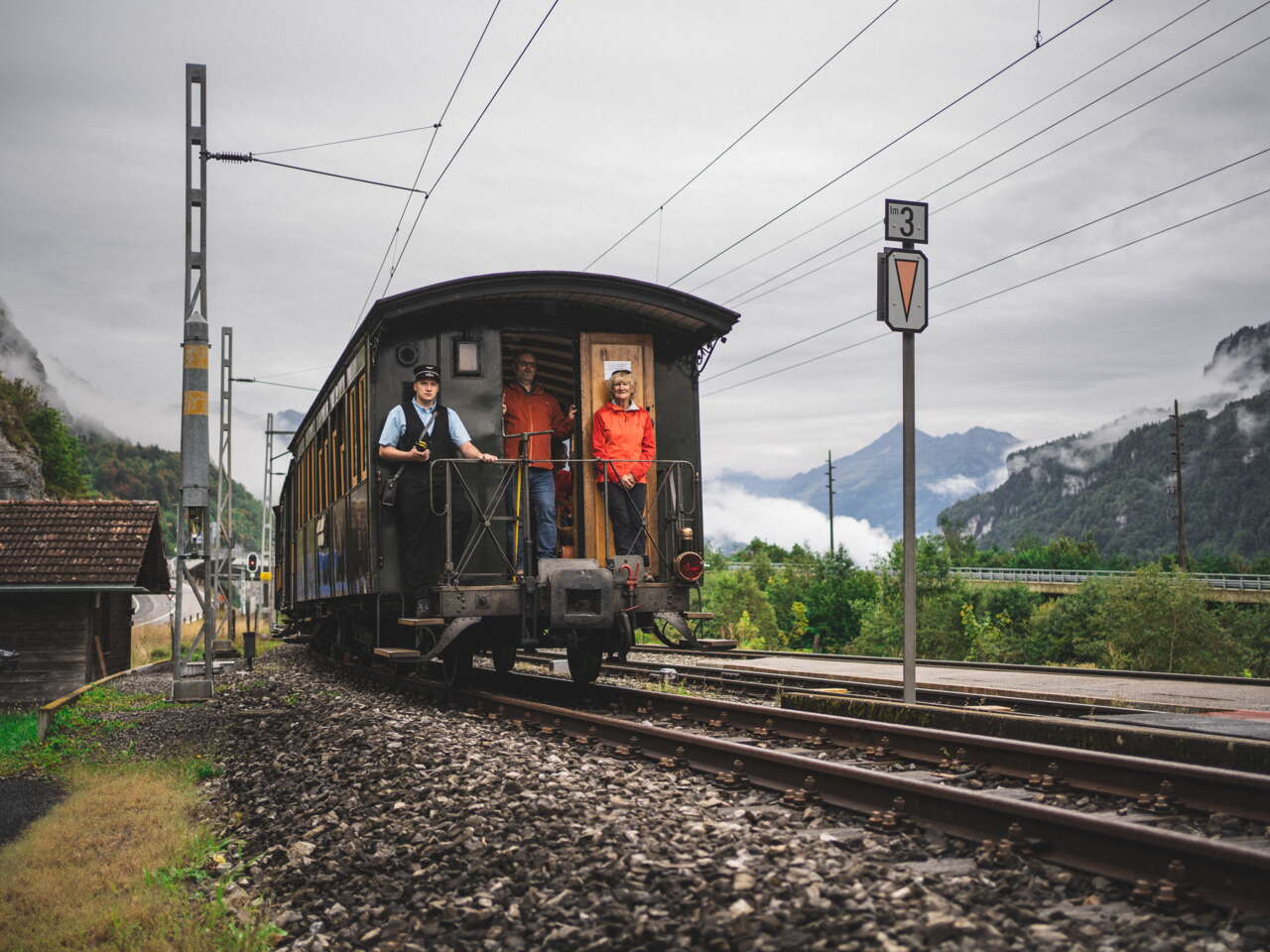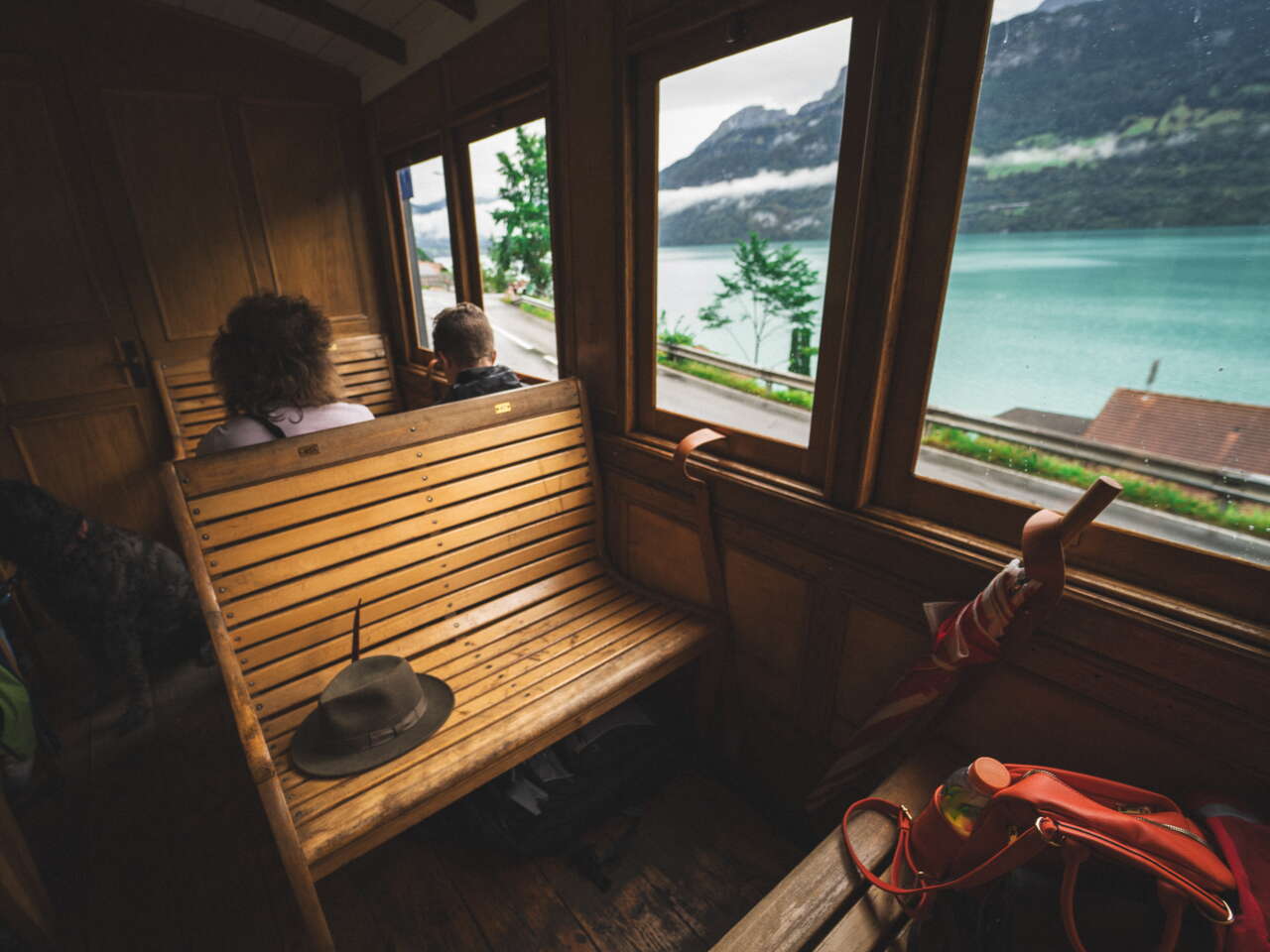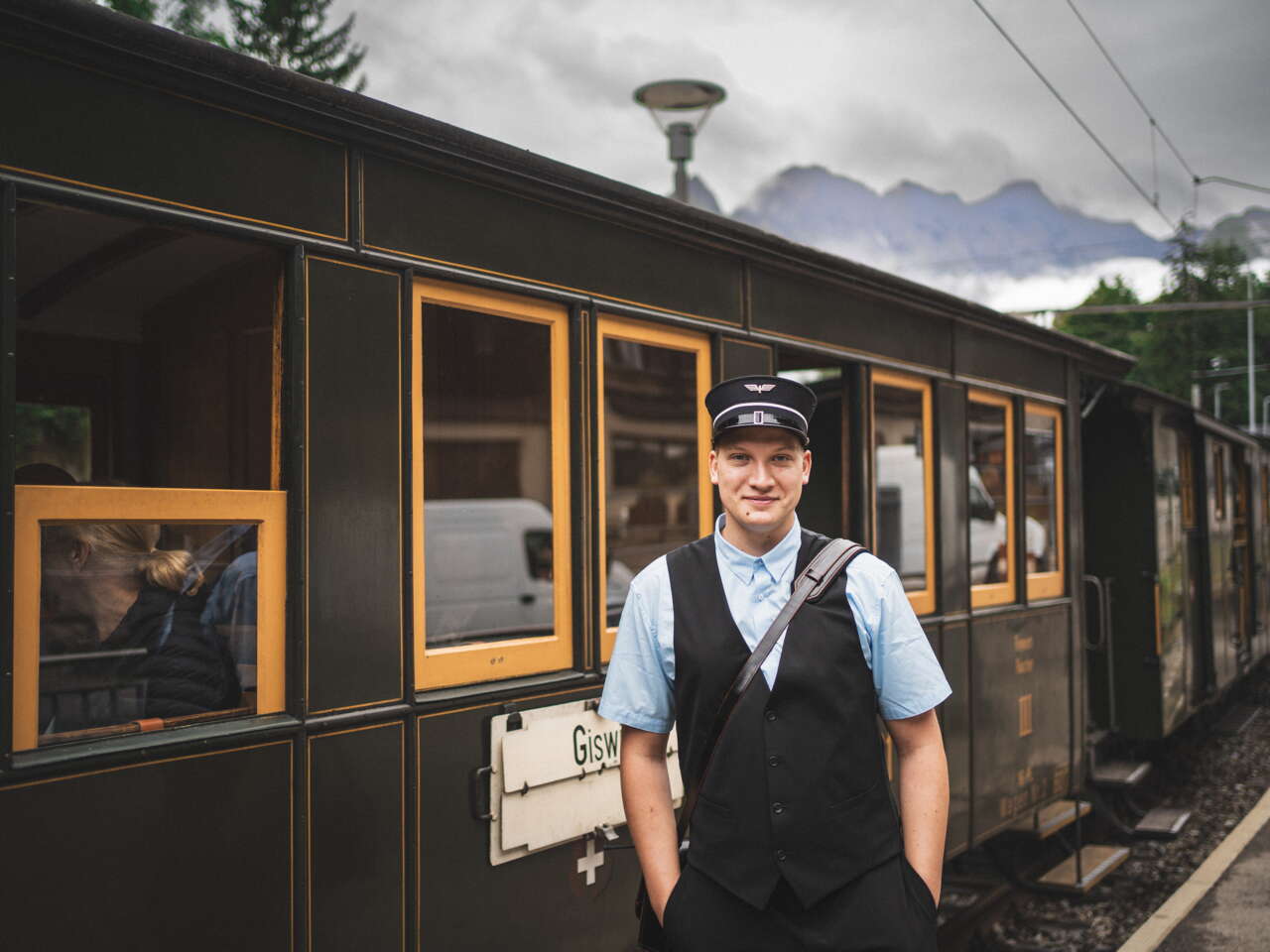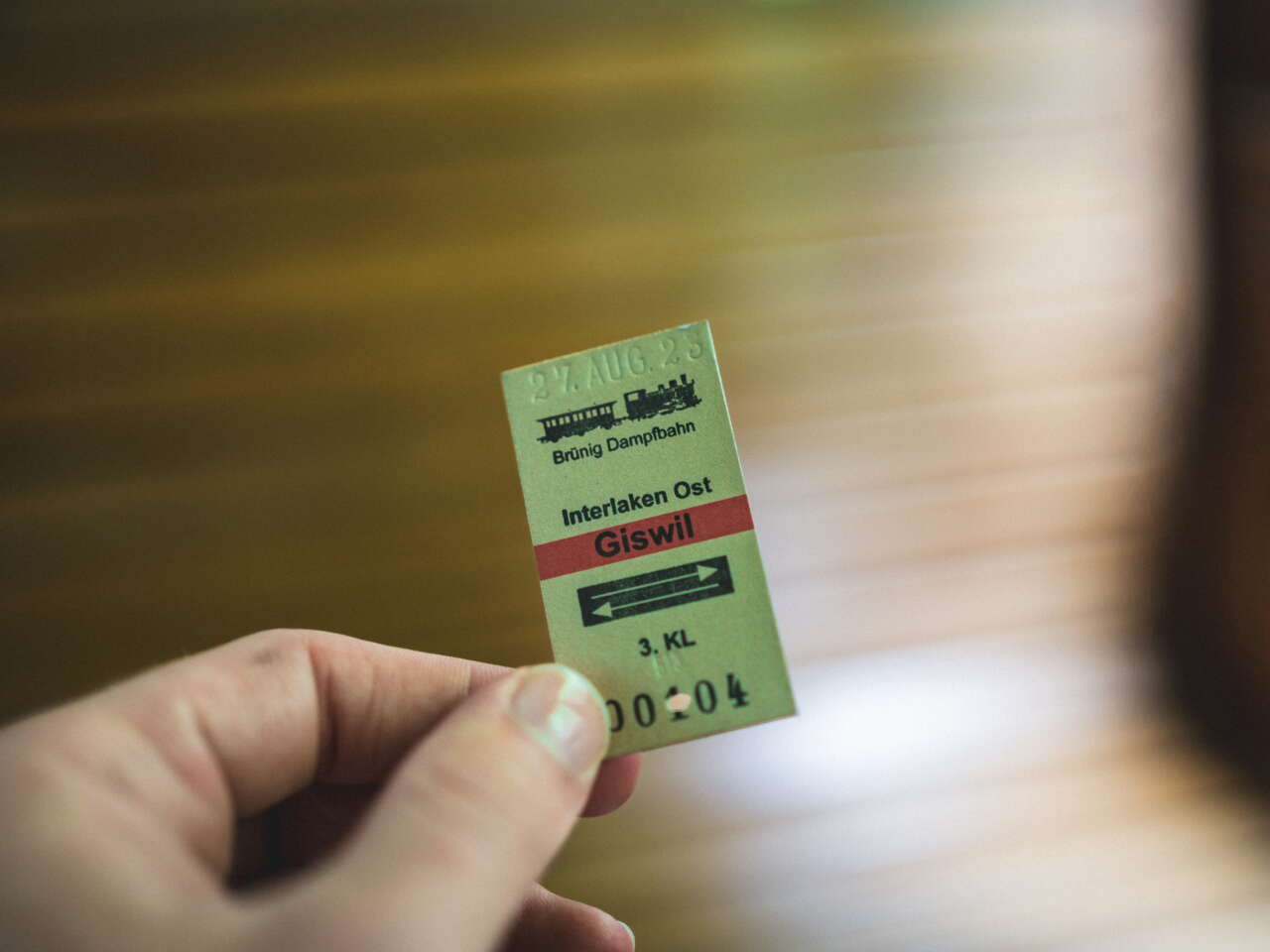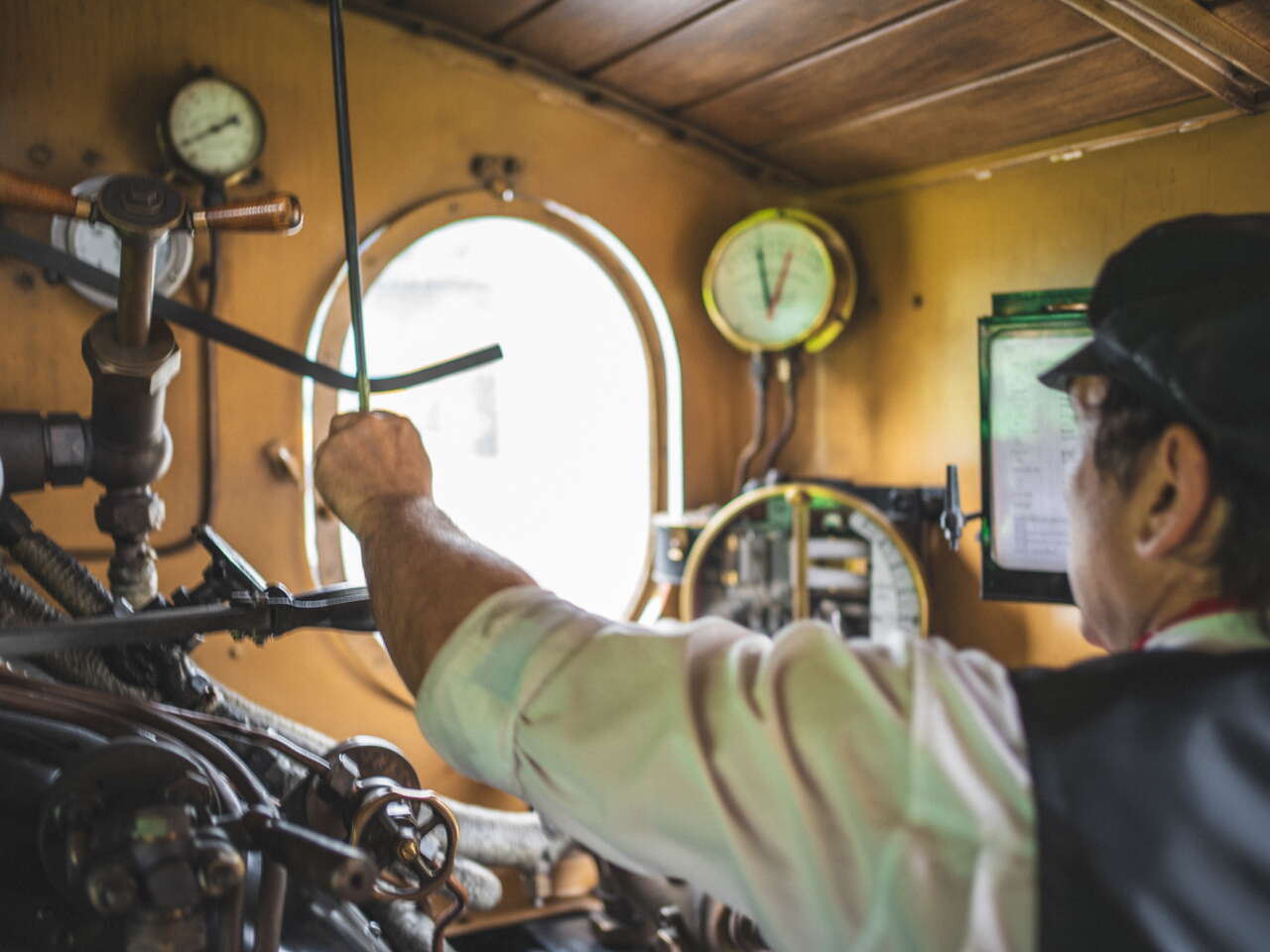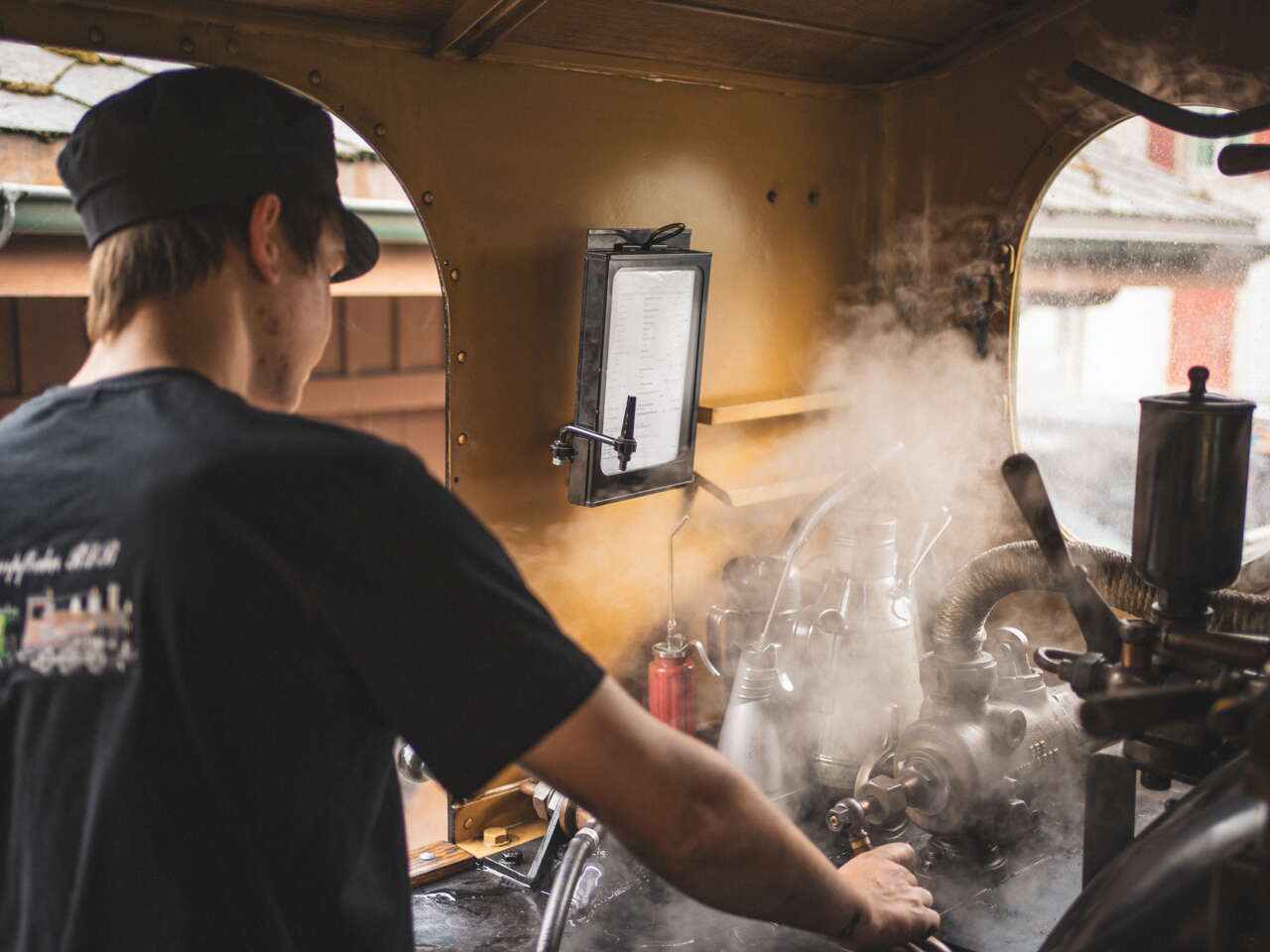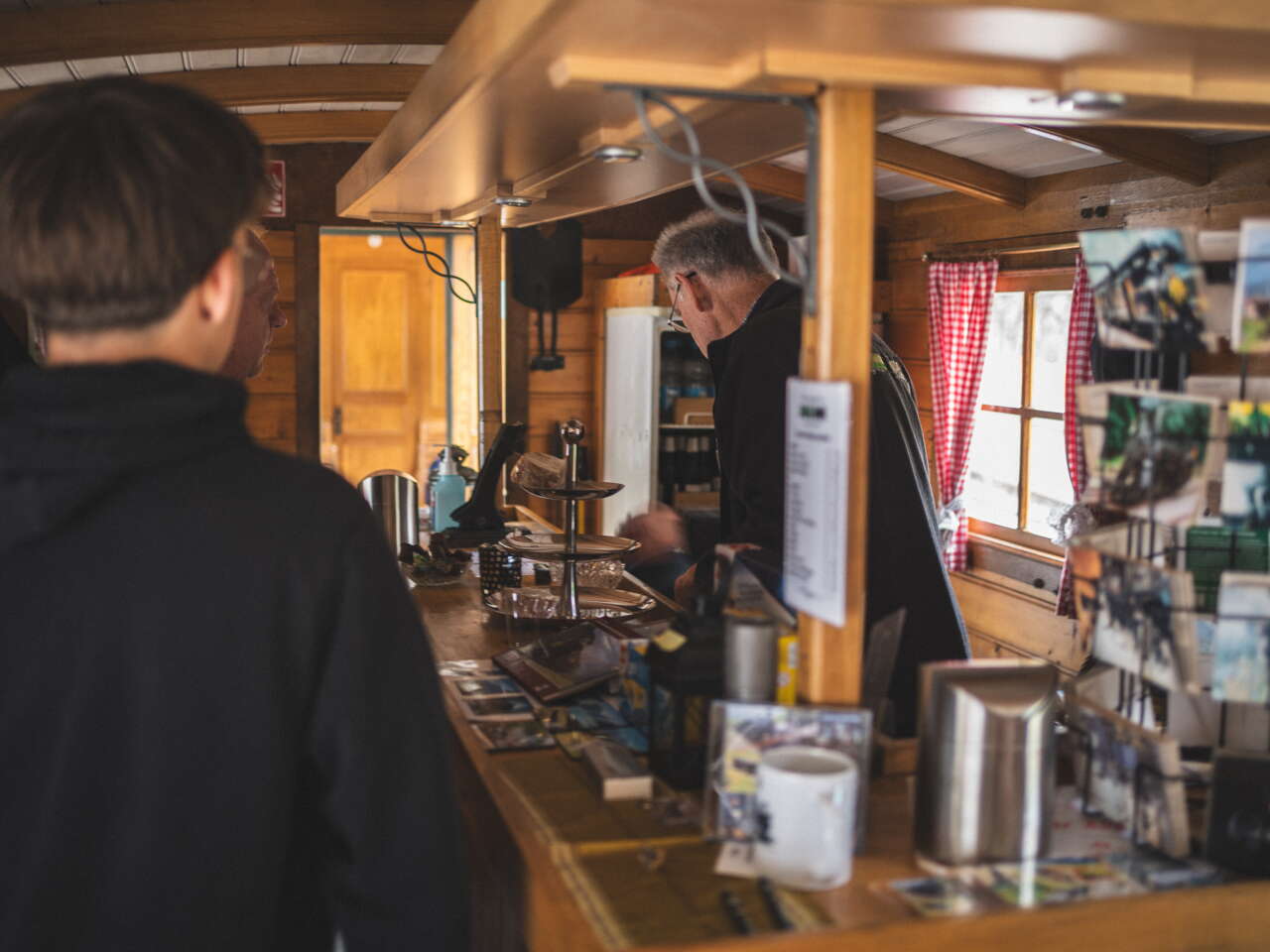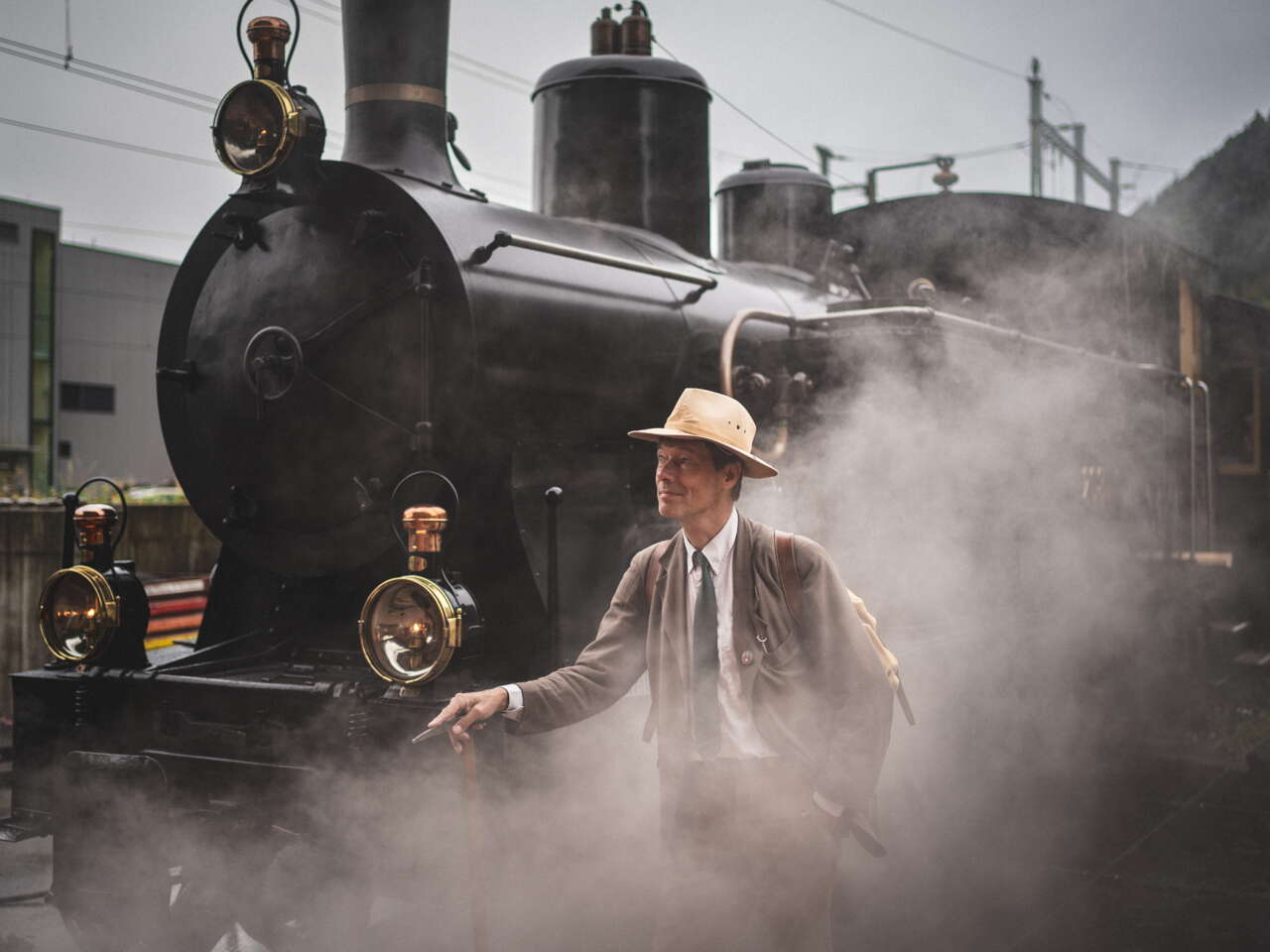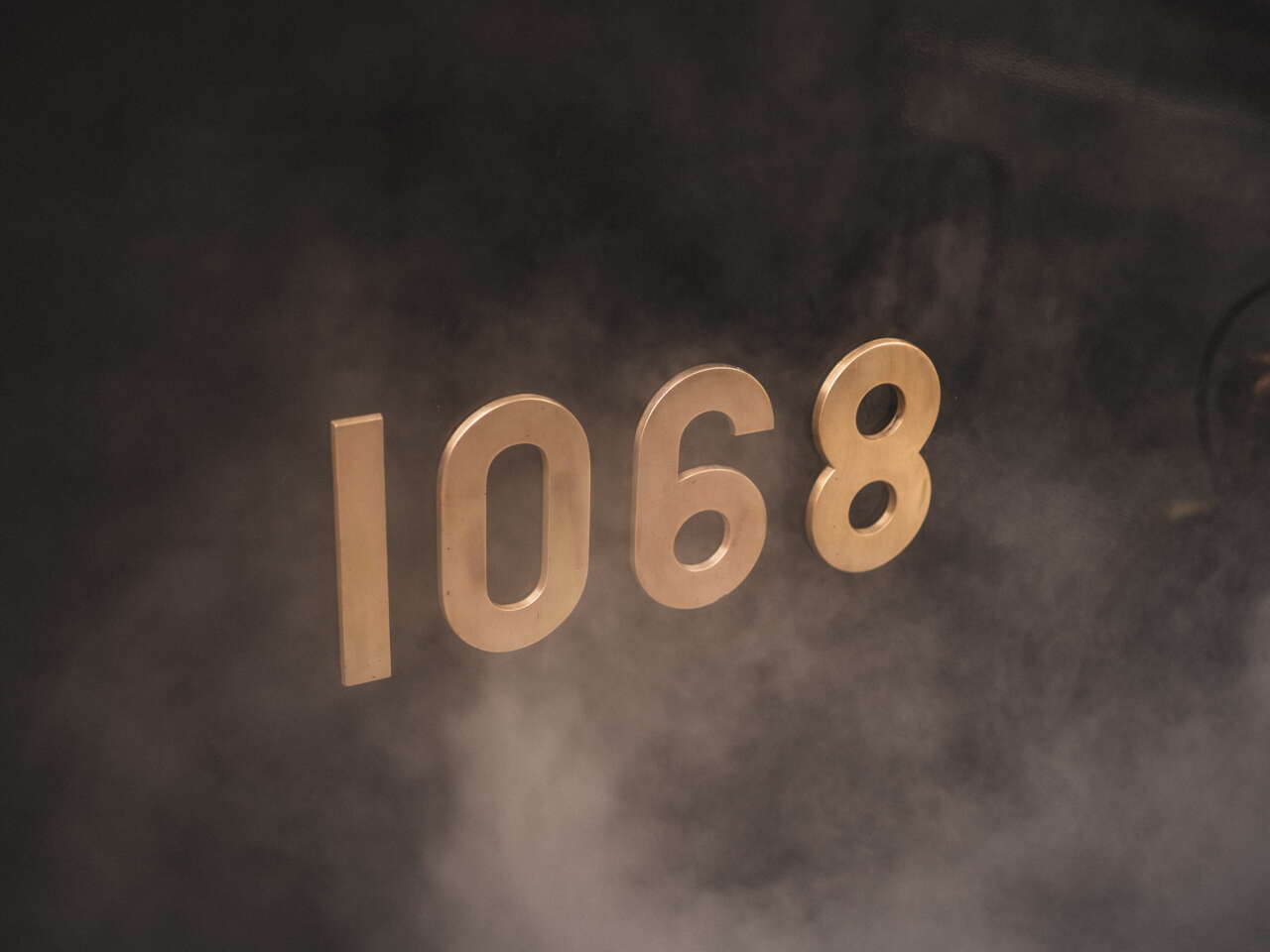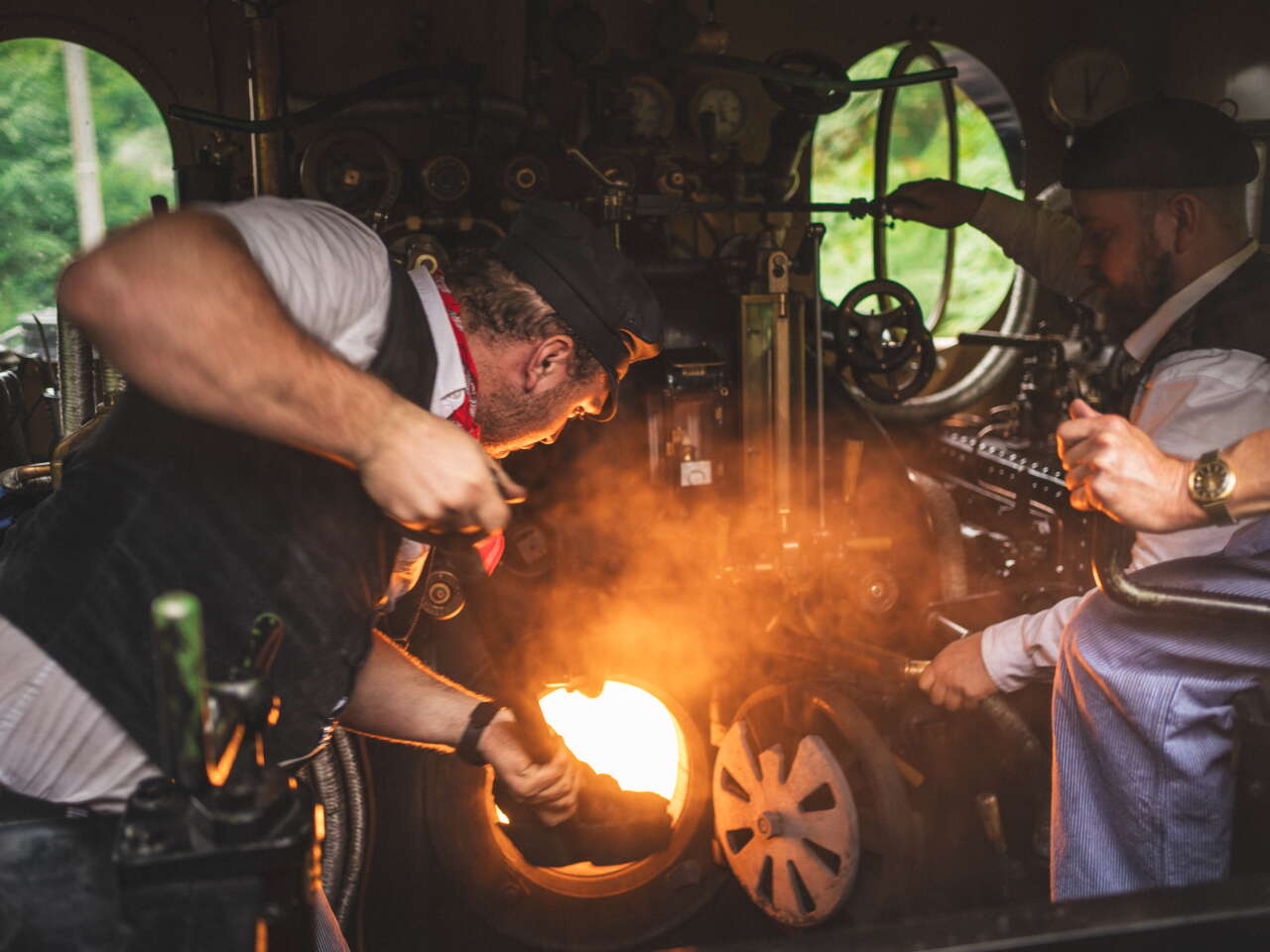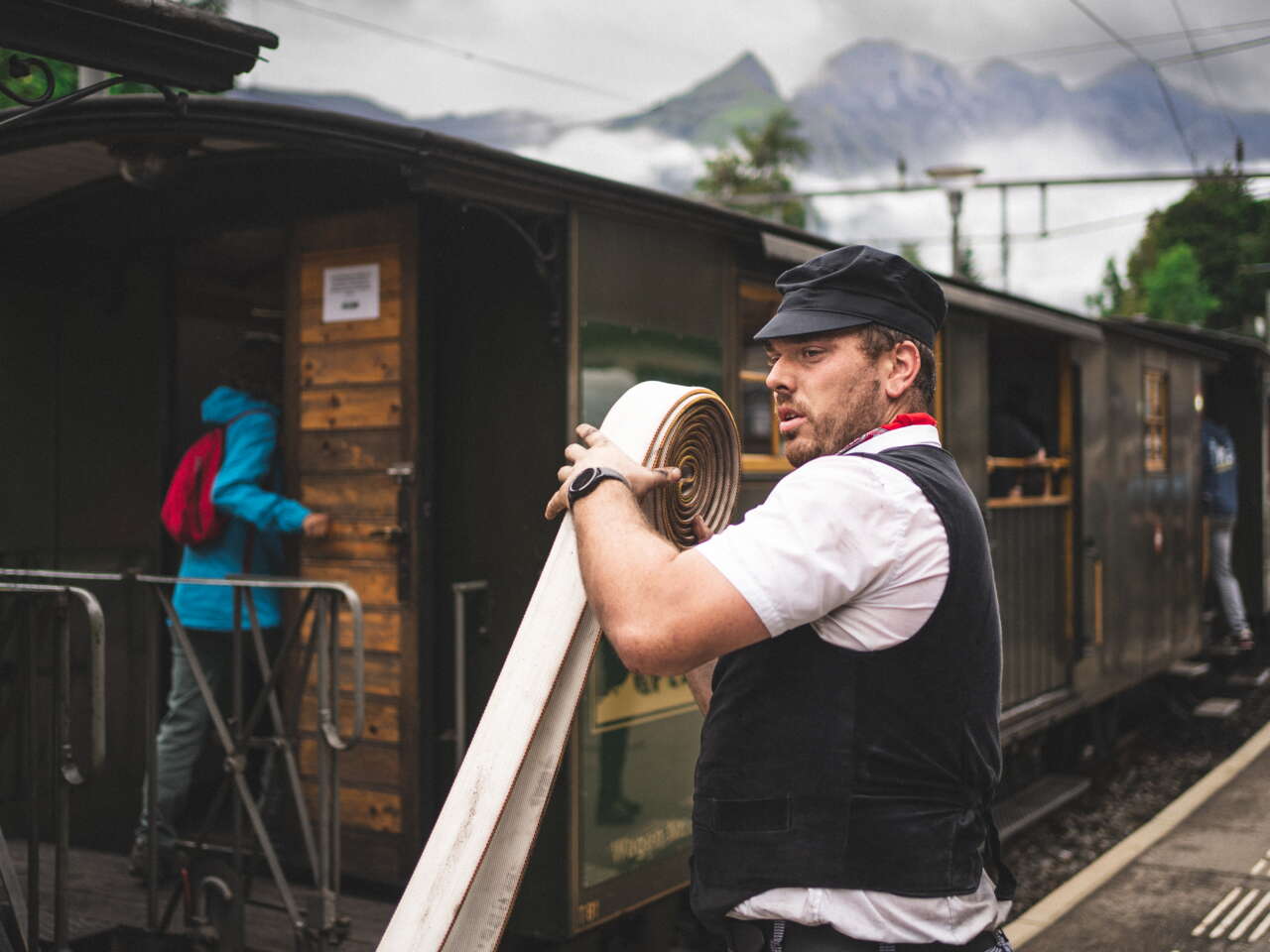Out and about with
the Brünig Steam Railway
Five times a year, the Brünig Steam Railway runs for the public from Interlaken Ost via the Brünig Pass to Giswil. An experience report.
Sunday morning, 7.30 am. The Brünig Dampfbahn depot at Interlaken Ost station is bustling with activity. Andreas "Andy" Alig, locomotive driver and workshop employee, greets us. He is working on the type G 3/4 locomotive (number 208). "We'd better do without shaking hands," he says - and laughs. His hands are full of oil. Minutes later he fills boiler after boiler with coal, which is then emptied into the driver's cab of the locomotive. And a brake test is also carried out. He has been on site since 5 o'clock in the morning. A journey with the steam train needs its lead time. The locomotive was even heated up the evening before.
The briefing
It is now 8.15 am. Andy Alig asks for a briefing in the depot's recreation room. He goes through the operational procedure with the team - 16 people, from the engine drivers to the bar staff, from the marketing manager to the train attendants. At which stops are passengers allowed to get off, and at which are they not? What has to be observed when changing the locomotive in Meiringen? Where does the steam train have to be sidled up so that the Zentralbahn, which runs on this route, can pass undisturbed? There is a huge amount of organisation behind the journey. The whole day is timed down to the minute. "We have to adhere strictly to that, or to the instructions by mobile phone from the Zentralbahn control centre in Stansstad," explains Andy Alig.
Boarding, please!
Back in front of the depot, the first passengers and onlookers have arrived. Just now the four cars from the century before last are being hitched up. Mobile phones are whipped out, but also expensive cameras. Hundreds, even thousands of pictures of the train composition are taken during the course of the day. The last details are mounted, such as the "headlights" - petroleum lamps - on the locomotive. The staff of the Brünig Steam Railway have changed their clothes in the meantime and are dressed as they were in the old days. The locomotive whistles for the first time. "Boarding, please!". Then the train starts steaming towards Interlaken Ost station, where more passengers join it.
Delicious coffee - great view
9.15 a.m.: Hardly on the way, Rosmarie Grossen and her granddaughter Amalia Grossen arrive with baskets full of drinks and sandwiches from carriage to carriage. We treat ourselves to a fine coffee. And we get to know Mike Ellis, Head of International Marketing and workshop employee. The Englishman is now working as a trolley attendant. "There has to be one attendant per wagon, that's the rule, for safety reasons," he explains to us. We sit in the rearmost wagon, through a door we get out into the open, we have a direct view of the tracks at the back - and of the turquoise-blue Lake Brienzersee. Speaking of blue, we look in vain for this colour in the sky. Instead of over 30 degrees as during the week, the thermometer shows only 15 to 20 degrees today. The sky is grey and wafts of fog pass us by. In the evening, looking at the photos, we realise: Maybe just the perfect weather for high-contrast shots.
On to the siding in Oberried
We share the carriage with six Swiss - and a larger tour group from England. So it's no coincidence that Mike Ellis is accompanying this particular carriage. He keeps telling us exciting stories about the Brünig Steam Railway in both German and English. 9.35 a.m.: We are now in Oberried and stop for the first time. The driver shunts the train. He first drives back into the tunnel, then stops on the siding of the station so that the Central Railway train can pass. There is a strict ban on disembarking here.
The good old cardboard tickets
A short time later we get the green light again. The train continues its journey. Comfortably, but still about 60 km/h fast, we drive along the Brienzersee. After all, our locomotive, built in 1913, is the fastest narrow-gauge steam locomotive in Europe. By the way, we sit in third class, slightly larger compartments are in second class. There is no first class. In the meantime, the conductors have arrived in our carriage. The tickets are checked. Marc Ritschard and Lars Weissenberger are responsible for this. They too are dressed in uniforms from the steam railway era. For our paper ticket we receive a cardboard ticket, as they used to be. A nice souvenir.
In the driver's stand - Part 1
10.10 am: The first official stop is in Brienzwiler. Passengers are allowed to disembark and go to the toilets, as urination is not possible on board. "That's both a curse and a blessing," says Mike Ellis, but he is glad that, in addition to all the other work, toilets don't have to be cleaned and maintained. From Brienzwiler to Meiringen, our photographer is allowed to take a seat in the driver's cab. With Andy Alig and Sandro Imboden. "Do you know anything about steam locomotives?" he is asked - and answered in the negative. "Would you like me to explain the most important things to you?" And so he gets first-hand information, while the scribbler goes to the bar car and treats himself to a sandwich.
Change of locomotive and driver
Melchior Anderegg also sits in the steam train, or at least a man dressed like the famous Meiringen mountain guide from the golden age of alpinism. It is Robertus Laan. He accompanies the "Moriarty Express", a guided tour that includes a ride on the steam train, a visit to the Reichenbach Waterfall and the Sherlock Holmes Museum in Meiringen. Once here, the group leaves the train. In the evening, on the return journey, they will board again. In Meiringen, the locomotive - the adhesion locomotive gives way to the 1926 vintage HG 3/3 1068 cogwheel engine, which has been prepared by a second team - and the drivers also have to be changed. "We otherwise end up with too many hours," explains Andy Alig, who in "normal" life is employed as a locomotive driver by Zentralbahn. "We have to respect the legal rest periods."
Up to the Brünig
10.50 a.m.: Ahead of us is the ascent to the Brünig Pass - from 595 m above sea level to over 1000 m above sea level. On this stretch alone, the railway will consume around 300 kilograms of coal and 2000 litres of water. For locomotive driver Nicolas Darioli and stoker Adrian Kehrli, who are now standing in the driver's cab at the front, this is a tough job. The driver opens the fire door almost every minute so that the stoker can shovel in more coal. The heat ensures that steam is generated from water. They always have to keep an eye on the water level - and the bar gauge. This should always be around 14 bar (maximum boiler pressure) during the entire ascent. Blowing valve, regulating valve - again and again wheels are turned and levers are pressed, the steering is optimised - and more or less "gas" is given. After 40 minutes, the pass is reached in the allotted time. Partly holey fire hoses are unrolled - water is refilled. Next year, the historic cistern and water crane will be in operation again. With a full water tank, the journey continues.
In the driver's stand - Part 2
From Brünig via Lungern and Kaiserstuhl down to Giswil I am allowed to take a seat in the driver's stand. The two drivers seem very attuned to each other. Because it is quite noisy, they communicate partly only with sign language. Only later do I learn that this is only the fourth time they have driven a public train over the Brünig. They keep glancing at their watches. The steam train is running one minute late. We pass Lungern, later Kaiserstuhl. The heat of the boiler and the monotonous jerking slowly make us tired. Shortly after 1 pm we arrive in Giswil. I am looking forward to the fresh air - and lunch.
Bratwurst with bread
A stall near the station sells bratwurst with bread. The empty stomach likes it. We observe that some passengers stay in Giswil, others join the train. And back on the platform we notice that the locomotive has been turned around and is just returning to the wagons. In other words: previously still directly behind the locomotive, we are now sitting in the last carriage for the return journey.
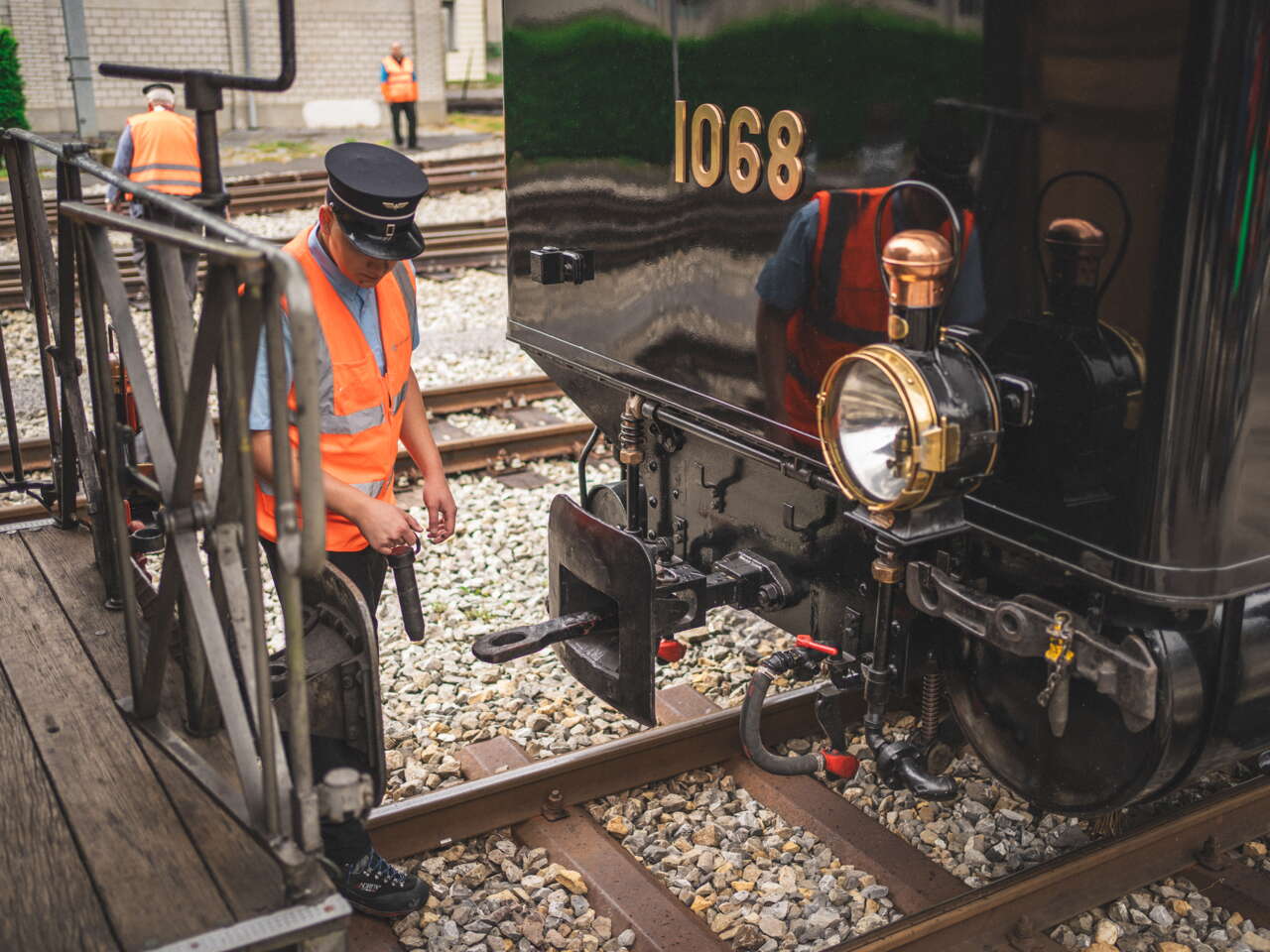
The fire brigade as constant companion
14.40 hrs: The steam train starts moving again with a full water tank and new coal. Up the Brünig - and down the Brünig again. On the way, we meet Sandro Böhringer and Silvan Grossmann from the fire alarm group every now and then. The two of them follow the steam train at intervals of about ten minutes. For safety reasons. If our steam train ride had taken place a week ago, it would probably have fallen victim to the drought. Last year, the cantonal fire and fireworks ban prevented one of the nostalgia rides.
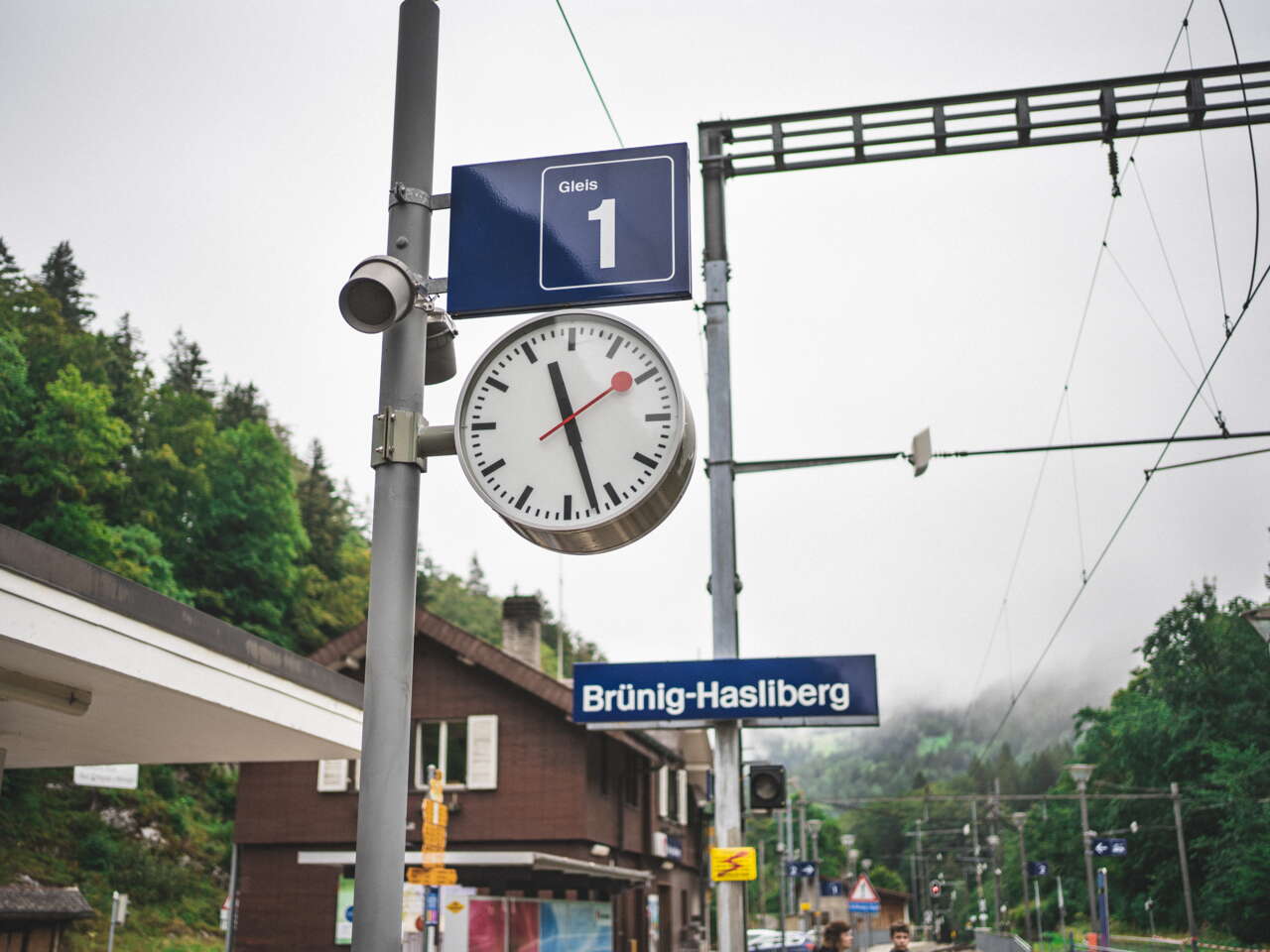
On to the turntable
16.40: In Meiringen we make a last major stop, also because some manoeuvres take place here, or to put it in the words on the official operating procedure: "Locomotive 1068 is unhitched, drives to the turntable, turn off, take water, drives to locomotive 208. Couple with locomotive 208 (pre-tensioning operation), switch track 3, hitch in front of the train and make brake test." In summary: We are pulled by two locomotives weighing around 30 tonnes at once for the last section.
End of work - at least for us
Exactly on time at 6.13 p.m. we are back in Interlaken Ost. The passengers leave the train happy, with many great memories and full memory cards. We too have finished our work, while the staff of the Brünig Steam Railway drive back to the depot. They still have to maintain the locomotives - they will still be hot the next day - and clean the carriages. Only then does a long day's work come to an end, a day of unpaid work, that is. The fact that the railway is running again at all is reward enough for the steam enthusiasts. Or the exuberant joy of the English tourist who is allowed into the driver's cab for the last section of the line and will probably tell her children and grandchildren about this experience. Yes, and we too will not forget the trip with the Brünig Steam Railway any time soon.

More information
Brünig Dampfbahn
Photos: Dennis Menoia
Story: Raphael Hadorn
Summer 2023
Contact
Haslital Tourismus
Tourist Center Meiringen
Bahnhofplatz 12
CH-3860 Meiringen
Tel. +41 33 972 50 50








